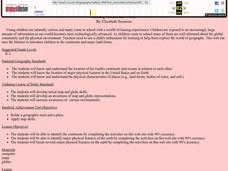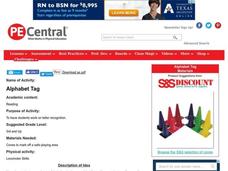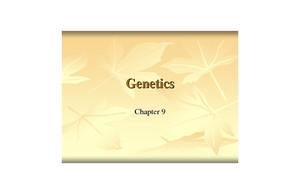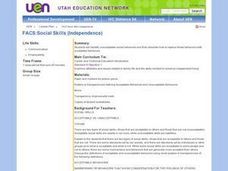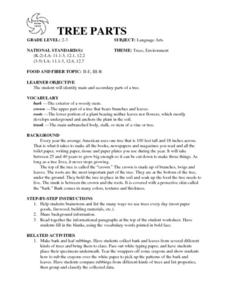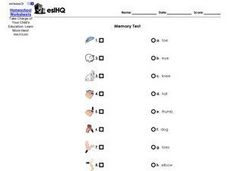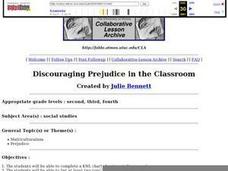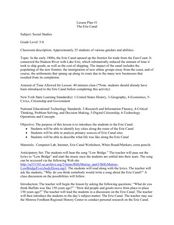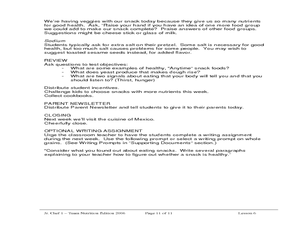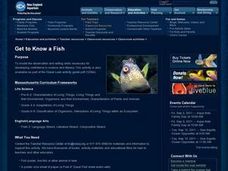Curated OER
Sight Words on a Snowy Evening
Students read various poems by Robert Frost. In groups, they use the text of one poem to identify sight words that are new to them. As a class, they listen to a recording of the poem and then repeating it outloud practicing their...
Curated OER
Reading Around the World
Students use the internet to identify the seven continents. Using maps, they locate and identify major physical features of Earth. They are read different books by various authors on the Earth and answer questions related to it. They...
Curated OER
Late Bloomers
Students demonstrate an understanding that individuals grow at various rates. In this health lesson, students read Leo, the Late Bloomer and identify ways to be tolerant of others. Students record the height of classmates and graph the...
Curated OER
Alphabet Tag
Students work on letter recognition as they play a game of tag. To get unfrozen they make a letter with their body and a free runner guesses the letter.
Curated OER
Genetics
Students identify literary elements in each selection while learning about diversity and the struggle for equality in the United States. They use their knowledge to express the emotion and key literary elements in each piece through...
Curated OER
Social Skills (Independence)
Third graders identify unacceptable social behaviors and then describe how to replace those behaviors with acceptable behaviors. They see that as individuals we are in charge of our bodies and minds, and therefore we choose our...
Curated OER
Soaring High with Fluency
First graders identify reading with speed, ease, and skill making it easier for them to comprehend text. They complete an activity using pseudo words, but first identifying what they are and how they are pronounced. Finally, 1st...
Curated OER
The Call to Greatness: A Search for Moral Integrity in the Urban Classroom
Eleventh graders read a variety of novels surrounding the theme of "greatness." In groups, they discuss various aspects of each novel and create a group bulletin board to identify and display the most important information from the...
Curated OER
A Balloon Dance
Students identify three different levels of movement and sensation of buoyancy, respond spontaneously in movement to the stimuli of imagery and feelings, and formulate his or her own unique sequence of movements based on personal...
Curated OER
Congratulations ! You're on a Parliamentary Committee
Tenth graders explain the expectations and evaluation criteria of this simulation of the committee process. They draft a bill / law to address an identified current problem or issue.
Curated OER
TREE PARTS
The student will identify main and secondary parts of a tree.1. Help young scholars brainstorm and list the many ways we use trees every day (most paper goods, firewood, building materials, etc.). 2. Share background information. 3. Read...
Curated OER
All's Well That Ends Well
Students examine and discuss the parts of a speech and how to organize them. They read sample speeches, then write a short presentation to read to the class, identifying the beginning, middle, and ending of their speech.
Curated OER
Memory Test
In this vocabulary worksheet, students match ten pictures with their names. Seven of the terms are body parts, two are animals, and the tenth term is hat. This worksheet is intended to be used with English language learners.
Curated OER
Discouraging Prejudice in the Classroom
Students investigate at least two types of prejudice in the classroom and create a KWL chart. Students identify prejudice that they have witnessed and write a paragraph explaining how the situation could solve differently.
Curated OER
The Eerie Canal
Students discover bodies of water in the United States by investigating the Eerie Canal. In this U.S. Geography lesson, students discuss Lake Eerie and the canal that was built in order to transport goods. Students research...
Curated OER
Through the Eyes of an Owl
Students describe vertebrates in terms of observable body parts and characteristics and describe life cycles of familiar organisms. They identify familiar organisms as part of a food chain or food web and describe their feeding...
Curated OER
A Tough Nut to Crack
Sixth graders explore agriculture by examining world geography. In this pecan cultivation lesson, 6th graders identify the history of the famous nut and the impact it has on the U.S. economy, diet and human body. Students define...
Curated OER
Time is In
Analyze the influence of culture, media, technology, and other factors on health. High schoolers will identify and recognize propaganda techniques (glittering generalities, bandwagon, sex appeal, testimonial, transfer, etc.) and write a...
Curated OER
Let's Go Shopping
Students review and identify common vocabulary related to food, shopping, and courtesy expressions. Students then practice English language skills by shopping in classroom market while playing roles of shoppers and store personnel.
Curated OER
Homes for Hermit Crabs
Students discover the differences between hermit crabs and mollusks and identify their parts. After reading a story about hermit crabs, they complete an anatomy worksheet. For another activity, students fold and cut a diagram of a hermit...
Curated OER
Hello My Name is . . . Helvetica
Students play various games to help create a classroom community. In this name recognition lesson, students combine their name recognition skills with newly learned art and geometric vocabulary. First students discover vocabulary that...
Curated OER
Jr. Chef Club Super Snacks Lesson 6
Students explore healthy snacks. In this nutrition and cooking lesson, students observe and identify food groups on USDA's MyPyramid food guide. Students discuss how fiber helps our digestive system and follow a recipe using yeast to...
Curated OER
Get to Know a Fish
Learners discover the anatomy of a fish by identifying its body parts. In this oceanography lesson, students view a live fish in their classroom and draw a poster of the fish one body part at a time while identifying it....
Curated OER
Lipid Worksheet
For this lipid worksheet, students answer questions about the structure and functions of lipids. They read about the three main lipids in the body including triglycerides, phospholipids and cholesterol and answer questions about each.



